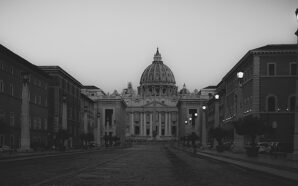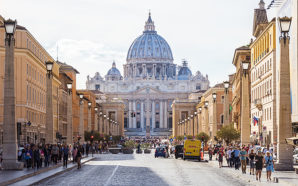More often than not it is through symbols rather than words that the important messages of a pontificate are communicated. So it has been with Pope Francis’ “penitential pilgrimage” to Canada, a visit aimed at making amends for the appalling abuse carried out against indigenous communities in state-funded, Catholic-run residential schools.
While the words of Francis’ apologies were sorely needed and long overdue, they were doubly poignant coming from an elderly Roman Pontiff using a wheelchair. The image of the Pope sitting in front of the Lac Sainte Anne, praying for healing and reminding his audience that it was on the Sea of Galilee that Jesus preached the Kingdom of God, will live on long in the memory. These moments in Canada also sent important messages to the whole Church.
First of all, the 85-year-old Pope has offered a face of the Church able to show humility, admit wrongdoing and ask for forgiveness. His use of an ordinary wheelchair and walking stick also shows a Church willing to embrace its own vulnerability and fragility. Such an approach overturns a deeply ingrained ecclesial view that while the Church may be made up of sinners, it is not a sinful Church. This attitude continues to prevail in the resistance—or lukewarm responses—to the global synod process of reform launched by Francis. There are a number of high-ranking prelates, supported by vocal supporters, who oppose any structural or institutional reforms of the Church. They might be happy to have a synod that focuses on culture war issues, but don’t want to look at anything that touches on internal change. They are uncomfortable in admitting the woundedness of the Church. Not so for Francis.
“In confronting the scandal of evil and the Body of Christ wounded in the flesh of our indigenous brothers and sisters, we too have experienced deep dismay; we too feel the burden of failure,” Francis said in a homily during Mass at the Sainte-Anne-de Beaupré Basilica in Québec.
What the abuse scandals of the past have revealed time and again is that it can no longer be Church business as usual, and Francis’ Canada visit underlines a willingness to face up to the past and make amends.
A fundamental element to this synodal process is a Church that learns to listen rather than simply find different ways to proclaim ready-made answers. Francis’ call is for the Church to go to the margins and the marginalized and be converted by the encounter. It is for this reason that indigenous communities, whether in Canada, Australia or the Amazon, are becoming some of the protagonists of the synodal journey. Interestingly, while Francis was in Canada, Cardinal Mario Grech, the leader of the synod office in Rome, was visiting indigenous communities in Guatemala. The Pope’s focus on the Indigenous in Canada was not about what he told them but learning the wisdom they have to offer. This was symbolized in Francis wearing the headdress of an indigenous chief and being given an indigenous name.
Second, the Pope’s Canada trip sent a message about the Church’s relationship with tradition. While some have attacked Francis’ focus on indigenous communities, most notably during the 2019 Amazon synod for its inclusion of indigenous symbols, he is seeking to recover elements of Catholic tradition. In his speeches Francis praised those missionaries to Canada who preserved native languages and cultures and cited the Bishop of Québec, Saint François de Laval, who stood up for indigenous against those who tried to demean them. The Jesuit Pope is pointing to the long tradition of inculturation whereby Christianity inserts, rather than imposes, itself into a local culture, something epitomized by the Jesuit missionary to China, Matteo Ricci, a Chinese scholar and adviser to the Emperor.
When Catholics became involved in running residential schools for indigenous, Francis argued, they had entered a worldly pact with colonial powers of the time and betrayed the Christian faith. It is something which serves as a warning to those in the Church seeking alliances with contemporary political powers. Throughout his pontificate, Francis has been calling for a deeper exegesis of Catholic tradition by focusing on the essentials of the Christian faith and warning against any drifts into ideology. And the synodal journey is a recovery of what it means to be the Church and is a process with deep biblical and theological roots.
“It is up to us to take on the tradition received, because that tradition is the living faith of our dead,” the Pope explained during the Mass at the Commonwealth Stadium in Edmonton. “Let us not transform it into ‘traditionalism,’ which is the dead faith of the living, as an author [Jaroslav Pelikan] once said.”
Francis, as he pushes on with reforms to the Church despite fragile health and physical pain, is pointing to the tradition articulated by the Apostle Paul when he wrote: “for when I am weak, then I am strong.”
Christopher Lamb is Vatican Correspondent for The Tablet and author of The Outsider: Pope Francis and His Battle to Reform the Church.
With thanks to Go, Rebuild My House, a publication of Sacred Heart University in Fairfield, Connecticut, United States. Reproduced with permission of the author.








